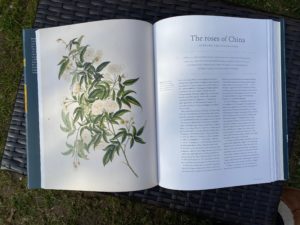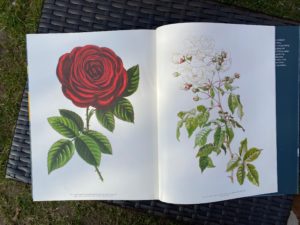Us Brits love our green spaces. We’re lucky to have a little garden and we love pottering round in it, filling it with colour every year. Our back wall is a sun trap and covered with climbing roses. We’ve always enjoyed roses, they seem such an essentially English plant. Which is why I was keen to review The Rose: The History of the World’s Favourite Flower told through 40 extraordinary roses which has recently been published by Welbeck Publishing.
The Rose: The History of the World’s Favourite Flower told through 40 extraordinary roses
 The Rose has been published in collaboration with the Royal Horticultural Society (RHS), the world’s largest gardening charity. It tells the story of the world’s favourite flower through 40 of the most popular and interesting species and hybrids. Arranged chronologically, The Rose brings to life the arrival of each flower in European gardens, detailing the history of the layout of rose gardens and the role that roses play in the ‘language of flowers’.
The Rose has been published in collaboration with the Royal Horticultural Society (RHS), the world’s largest gardening charity. It tells the story of the world’s favourite flower through 40 of the most popular and interesting species and hybrids. Arranged chronologically, The Rose brings to life the arrival of each flower in European gardens, detailing the history of the layout of rose gardens and the role that roses play in the ‘language of flowers’.
From the first recorded reference to a rose over 7,000 years ago, these extraordinary flowers have captivated botanists, artists, poets, perfumers and gardeners. A symbol of love and patriotism, a scent and flavour synonymous with the East, and the jewel in the crown of ornamental gardens, roses in all their forms bear a special meaning that spans centuries and crosses oceans.
 Extraordinary botanical illustrations and extracts from classic texts held in the Royal Horticultural society’s world-famous Lindley Library, such as Redoute’s Les Roses, Henry Andrew’s Roses, Mary Lawrence’s Selection of Roses and Victor Paquet’s Choix des Plus Belles Roses, complete this authoritative celebration. There are 30 beautiful fine art prints, which can be removed, framed and treasured.
Extraordinary botanical illustrations and extracts from classic texts held in the Royal Horticultural society’s world-famous Lindley Library, such as Redoute’s Les Roses, Henry Andrew’s Roses, Mary Lawrence’s Selection of Roses and Victor Paquet’s Choix des Plus Belles Roses, complete this authoritative celebration. There are 30 beautiful fine art prints, which can be removed, framed and treasured.
This is a lovely coffee table style book to dip in and out of. It’s a lovely way to learn more about the history of roses and the illustrations are stunning. This would make a great gift for those who love flowers.
Thank you to Welbeck Publishing for gifting us a copy of this book.








